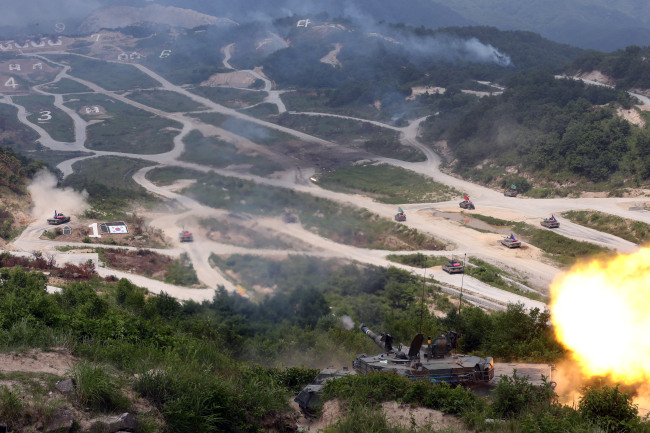 |
South Korean and U.S. armed forces hold their largest live-fire exercise in Pocheon, Gyeonggi Province, Friday to mark the 62nd anniversary of the start of the Korean War. The exercise involved more than 2,000 troops, F-15K combat fighter planes, Apache attack helicopters and tanks. (Yonhap News) |
A nuclear-powered American aircraft carrier is in position off the west coast of South Korea to lead large-scale military exercises aimed at honing the two countries’
joint capability to cope with North Korean aggression, Seoul officials said Friday, amid the North’s saber-rattling.
About 10 warships and submarines, including the George Washington Carrier Striker Group; 8,000 personnel; and hundreds of combat aircraft from the allies will take part in the three-day exercises from Saturday, said officials at Seoul’s Joint Chiefs of Staff (JCS).
The drills, a follow-up of a two-day, trilateral naval drill with Japan in waters south of Jeju Island, will be held off the west coast town of Taean, 150 kilometers south of Seoul, JCS officials said.
“Throughout the joint military exercises, South Korean and U.S. forces will show off their resolute capabilities,” Navy Brig. Gen Park Seong-bae said.
“We will immediately retaliate against any provocations from North Korea.”
Tension on the Korean Peninsula remains high following the North’s two military attacks that killed 50 South Koreans, mostly soldiers. The South’s military has vowed a tougher retaliation if provoked again.
North Korea defied international warnings again in April by launching a long-range rocket, although it ended in failure. The international community strongly condemned the launch as a cover to test international ballistic missile technology.
This week’s joint drills are partly aimed at testing the allies’ ability to track and monitor a North Korean long-range missile on the assumption that the North launches such a missile, JCS officials said.
They also plan to practice skills to detect and destroy North Korean submarines, according to JCS officials. (Yonhap News)







![[Today’s K-pop] Blackpink’s Jennie, Lisa invited to Coachella as solo acts](http://res.heraldm.com/phpwas/restmb_idxmake.php?idx=644&simg=/content/image/2024/11/21/20241121050099_0.jpg)
